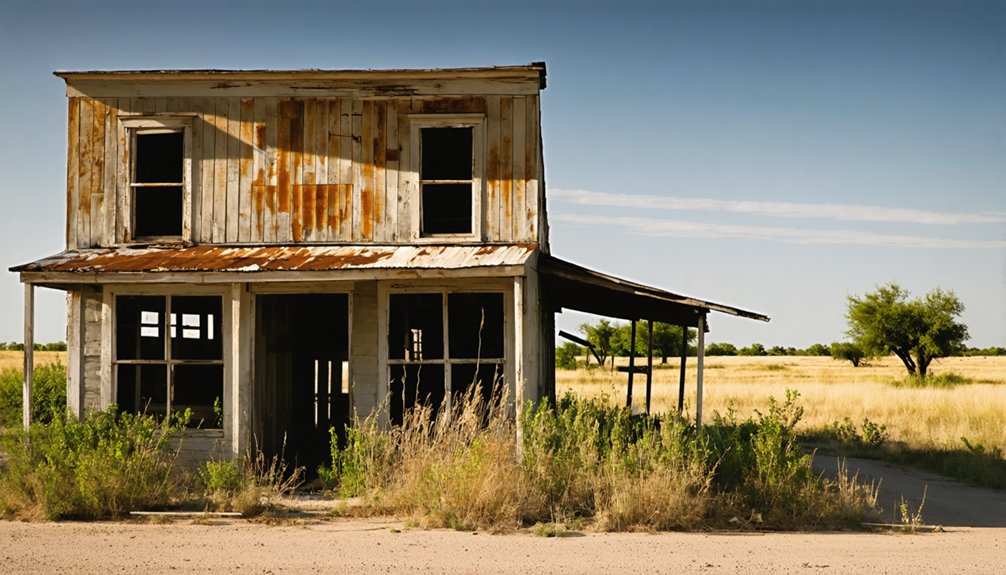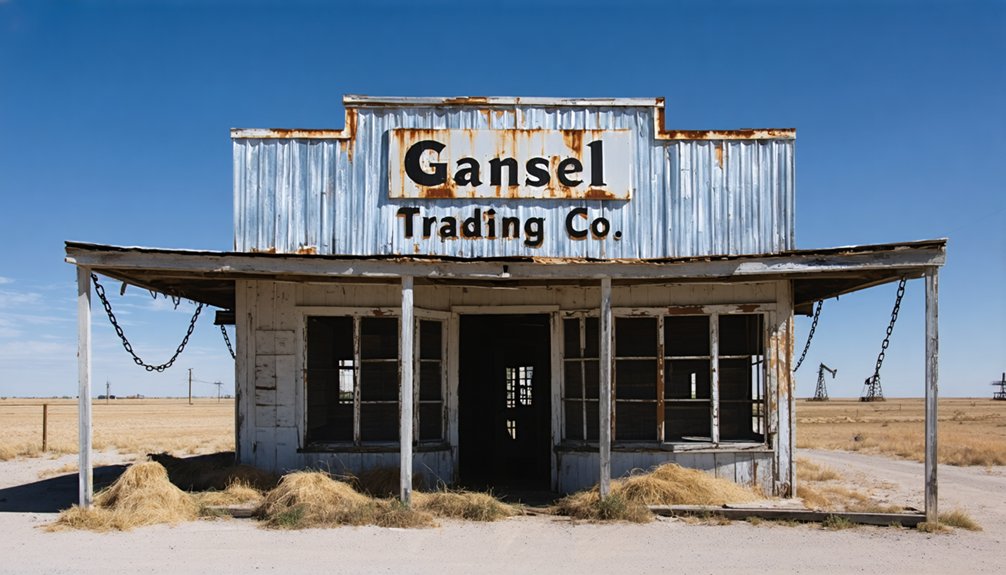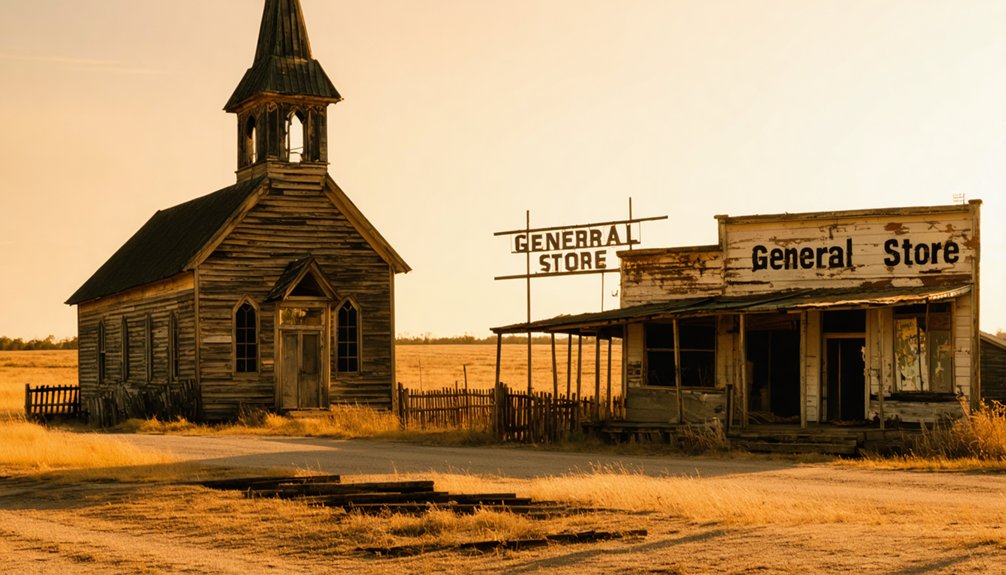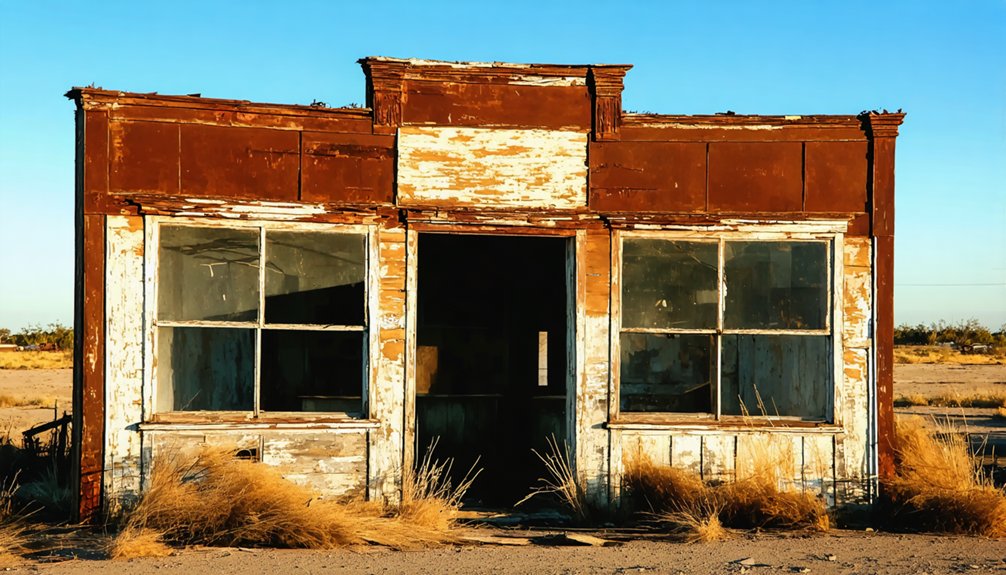You’ll find Gansel’s ghost town ruins 28 miles northwest of Brady, Texas at the intersection of FM 503 and FM 765. Originally denied its name by postal authorities in 1911, the settlement became known as Doole and flourished with 250 residents by the 1940s. Today, you can explore concrete bleachers from the 1908 school’s sports field and various roofless structures. The town’s transformation from bustling community to abandoned site tells a fascinating story of rural Texas’s evolution.
Key Takeaways
- Originally named Gansel, the town was renamed to Doole in 1911 after postal authorities denied the initial name.
- The settlement reached its peak population of 250 residents during the 1930s and 1940s before declining.
- Concrete bleachers from the old school sports field remain as prominent ruins at the abandoned townsite.
- The ghost town is located 28 miles northwest of Brady, Texas, at the intersection of FM 503 and FM 765.
- The site retains archaeological significance with scattered building ruins, weathered walls, and rusted machinery parts from its mining past.
From Gansel to Doole: A Name’s Journey

While the settlement originally bore the name Gansel after a prominent local family, postal authorities‘ denial of this name in 1911 led to an important shift in the community’s identity.
When you look at Gansel history, you’ll find the settlement first developed around Crossroads School after its relocation from Fort Concho in 1908.
The Doole significance emerged when David Doole Jr., the postmaster of nearby Brady, helped guide settlers through the postal application process.
In appreciation of his assistance, the community chose to rename their town after him.
This strategic name change proved successful – the postal authorities approved “Doole” as the official designation, securing the town’s place in Texas history and ensuring essential mail service for its residents. Today, the ghost town still maintains its own zipcode despite its abandoned status.
The town experienced its peak in the 1940s when the population reached two hundred fifty residents.
Peak Years and Community Life
During Doole’s peak years in the 1940s, you’d have found a bustling community of around 250 residents supported by ten local businesses, including a diner, grocery store, and mechanic’s shop.
You could’ve attended regular gatherings at the local church or participated in community events centered around the school, which served as primary social institutions for the town’s families. Similar to Thurber’s economy, locals were dependent on the company store system where workers had to use scrip for their purchases.
If you’d visited during this period, you would’ve witnessed a self-sufficient ranching community anchored by the intersection of FM 503 and FM 765, where most of the town’s commercial activity took place. Like the town of Barstow, the community faced hardship when severe droughts devastated the local farming operations.
Population Growth Years
As the population of Gansel steadily grew from its 1908 founding, the town, renamed Doole in 1911, reached its zenith between the 1930s and 1940s with approximately 250 residents.
The settlement patterns started with the Gansel family’s arrival and quickly expanded as ranching and farming opportunities drew more settlers to the area. The town’s location helped maintain stability, unlike many rural Texas communities that faced significant population losses. The area’s growth mirrored the development seen in 511 ghost towns across Texas during the period of westward expansion.
You’ll find that the population dynamics shifted from just 25 residents in 1914 to a thriving community within two decades.
- A school built in 1908 marked the first community building, serving local children and establishing an educational foundation.
- By 1910, the first stores appeared as commercial activity increased.
- The community developed around the crossroads of Farm to Market Roads 503 and 765, creating a strategic location for growth.
Community Hub Activities
In its heyday between the 1930s and 1940s, Gansel’s community life centered around several key institutions that shaped daily activities.
You’d find the 1908-established school at the heart of social gatherings, complete with football and baseball fields featuring permanent cement bleachers. The church served as another essential hub, hosting weekly services and community events that strengthened local bonds.
Nearly ten businesses, including a grocery store, diner, and mechanic’s shop, created spaces where you’d encounter neighbors going about their daily routines. With a peak of 250 inhabitants during this period, the town maintained a close-knit atmosphere. Similar to Longfellow, which was primarily a railroad station, Gansel relied heavily on rail transportation for its economic stability.
The post office, operating under the name Doole since 1911, connected residents to the outside world. Sports events drew spectators regularly, while the diner became an informal meeting spot where you’d catch up on local news and share stories with fellow townspeople.
What Remains Today
If you visit Gansel’s location today, you’ll find concrete bleachers from the old school’s sports field standing as one of the most prominent remaining structures.
You can access the site via County Road 227, where scattered building ruins and foundations mark the former townsite. Like many Texas communities, Gansel experienced a steep decline when transportation patterns shifted away from rail-dependent towns.
The bleachers serve as a distinctive landmark among the few surviving physical remnants of this once-active Texas community. Unlike coastal towns such as Indianola, which was completely destroyed by hurricanes, Gansel’s structures slowly deteriorated over time.
Standing Structures and Ruins
The scattered ruins of Gansel paint a stark picture of abandonment typical of Texas ghost towns.
You’ll find numerous roofless structures and foundations, with most buildings reduced to stone footings and rubble. The site’s ruins exploration potential lies mainly in its archaeological significance, showcasing scattered mining equipment and industrial remnants that hint at its mining heritage.
- Weathered walls and partial structures stand guard over the town’s history, though most roofs and upper sections have long since collapsed.
- Rusted machinery parts and mining apparatus dot the landscape, partially buried beneath years of natural reclamation.
- A natural spring near the ruins supports unique vegetation, marking the townsite’s original boundaries.
All structures are now fenced off with “no trespassing” signs, making this more of an archaeological site than a traditional ghost town visit.
Concrete Sports Bleachers
Standing as silent sentinels to Gansel’s sporting past, concrete bleachers remain the most prominent physical remnants of the town’s athletic facilities.
You’ll find these weathered structures near the intersection of FM 503 and FM 765 in western McCulloch County, where they’ve endured decades of Texas climate. The bleacher architecture, reminiscent of a small Roman amphitheater, features tiered seating designed for the local school’s football and baseball games during the 1930s and ’40s.
While wooden buildings have long since vanished, these poured concrete stands persist as a symbol of community memories.
They mark the epicenter of what was once Gansel’s primary gathering place, where ranchers’ and farmers’ families would congregate to cheer on their school teams, embodying the spirit of rural Texas life.
Location and Access Points
Located in western McCulloch County near the convergence of FM 503 and FM 765, Gansel’s remaining traces require careful navigation through unmarked rural roads.
The ghost town geography presents significant access challenges, as you’ll need a high-clearance vehicle to traverse the deteriorating pathways. No official signage marks the site, and you’ll find yourself relying on local knowledge or historical maps to pinpoint the location.
- The site sits among overgrown fields and natural vegetation, with few visible markers indicating its former existence.
- Access routes consist primarily of unpaved rural roads that may become impassable during wet weather.
- You’ll need to coordinate with local landowners, as much of the surrounding area is now private property.
The Economic Rise and Fall

As cotton fields stretched across the Texas landscape in 1857, Cheapside emerged as a thriving agricultural community, anchored by Thomas Baker’s early settlement and subsequent waves of shopkeepers who established the town’s commercial foundation.
The town’s economic resilience was evident in its diverse infrastructure, including multiple stores, a broom factory, blacksmith shop, and cotton gin-gristmill complex built in 1889.
You’d have found agricultural diversification through poultry and livestock operations alongside the dominant cotton industry. Daily stagecoach service connected traders to broader markets, while social institutions like the Masonic lodge and church strengthened community bonds.
Despite reaching a peak population of 500 during the Depression, Cheapside’s prosperity couldn’t withstand the combined pressures of boll weevil infestations, mechanization, and declining cotton profits.
Local Geography and Climate
The stark geographical features of Gansel, now known as Doole, played a significant role in shaping its destiny just as economic forces did. You’ll find this ghost town 28 miles northwest of Brady, Texas, where FM 503 and FM 765 intersect. The region’s semi-arid climate created constant challenges for land use, forcing settlers to adapt to temperature extremes and unpredictable rainfall patterns.
- Rolling hills and flatlands supported ranching operations, with native grasses providing grazing for livestock.
- Water scarcity shaped climate adaptation strategies, as settlers relied on wells and small creeks for survival.
- Mixed vegetation of mesquite, oak trees, and drought-resistant plants characterizes the landscape today.
The harsh environmental conditions, including scorching summers and periodic droughts, contributed to the town’s eventual abandonment, as residents struggled to maintain sustainable agricultural practices in this unforgiving terrain.
Historical Legacy and Tourism Impact

While many Texas ghost towns fade into complete obscurity, Gansel – now known as Doole – maintains a unique historical footprint through its active ZIP code (76836) and prominent ruins.
You’ll find evidence of its rural heritage in the cement bleachers that once served the town’s first school, built in 1908. During its peak in the 1930s and 1940s, the community thrived with 250 residents, a church, and ten businesses.
Today, you can explore this ghost town’s remnants near Brady, Texas. Though there aren’t any operating businesses or accommodations, history buffs and curiosity seekers continue visiting the site to examine the Roman-style bleachers and building foundations.
The town’s evolution from a bustling farming community to abandonment reflects the broader changes in Texas agriculture post-World War II.
Frequently Asked Questions
What Happened to the Original Gansel Family After the Town’s Name Changed?
Fading, moving, disappearing – you can’t trace the Gansel legacy after 1911’s name change to Doole. Historical records show no evidence of family descendants remaining, suggesting they either relocated or quietly assimilated into other communities.
Were There Any Notable Crimes or Scandals in Doole’s History?
You won’t find any mysterious disappearances or unsolved murders in Doole’s records. Historical sources indicate it remained a peaceful ranching community until economic factors led to its decline as a ghost town.
Did Any Famous People Ever Live in or Visit Doole?
Quiet as a church mouse, you won’t find any famous visitors or celebrity sightings in Doole’s history. Historical records show only local figures like David Doole Jr., the Brady postmaster who influenced the town’s name.
What Kinds of Community Celebrations or Annual Events Were Held There?
You’d find typical rural community gatherings at the school’s sports events, seasonal agricultural celebrations, church socials, and local business-hosted festivities. These celebration traditions centered around harvests, holidays, and sports.
Are There Any Documented Paranormal Activities or Ghost Stories From Doole?
Like a blank canvas waiting for its first brushstroke, you won’t find any documented ghost sightings or local legends from Doole. Historical records and paranormal databases show no supernatural activity there.
References
- https://www.desertedtexas.org/2015/07/doole-texas-76836/
- https://www.youtube.com/watch?v=phjUE19A8HM
- https://www.ghosttowns.com/states/tx/doole.html
- https://en.wikipedia.org/wiki/List_of_ghost_towns_in_Texas
- https://www.houstonchronicle.com/news/houston-weather/article/texas-ghost-towns-extreme-weather-hurricanes-19874031.php
- https://www.ctpost.com/news/slideshow/Ghost-towns-around-Texas-95681.php
- https://www.texasescapes.com/TOWNS/Doole/Doole.htm
- https://www.tshaonline.org/handbook/entries/doole-tx
- https://www.texasescapes.com/TOWNS/Texas-Ghost-Towns-2-Central-Texas.htm
- https://www.desertedtexas.org/blog/



